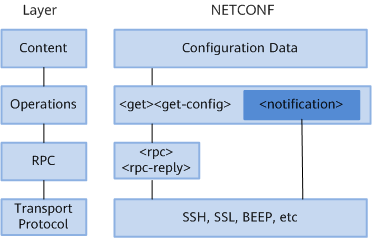NETCONF Protocol Framework
Like the open systems interconnection (OSI) model, the NETCONF protocol framework also uses a hierarchical structure. Each layer encapsulates certain functions of NETCONF and provides services for its upper layer.
The hierarchical structure enables each layer to focus only on a single aspect of NETCONF and reduces the dependencies between different layers. In this way, the impact that internal implementation imposes on other layers can be minimized.
Figure 1 describes the layers of the NETCONF protocol framework.
Table 1 describes the meaning of each layer.
Layer |
The following is an example: |
Specifications |
|---|---|---|
Layer 1: Transport Protocol |
BEEP, Secure Shell (SSH), and Secure Sockets Layer (SSL) |
The transport layer provides a communication path for interaction between a NETCONF client and the server. NETCONF can be carried on any transport protocol that meets all of the following requirements:
NOTE:
Currently, the device only supports SSH as the transport layer protocol of NETCONF. |
Layer 2: RPC |
<rpc> and <rpc-reply> |
The RPC layer provides a simple RPC request and response mechanism independent of transport protocols. The client uses the <rpc> element to encapsulate RPC request information and sends the RPC request information to the server through a secure and connection-oriented session. The server uses the <rpc-reply> element to encapsulate RPC response information (content at the operation and content layers) and sends the RPC response information to the client. In normal cases, the <rpc-reply> element encapsulates data required by the client or information about a configuration success. If the client sends an incorrect request or the server fails to process a request from the client, the server encapsulates the <rpc-error> element containing detailed error information in the <rpc-reply> element and sends the <rpc-reply> element to the client. |
Layer 3: Operations |
<get-config>, <edit-config>, and <notification> |
The operation layer defines a series of basic operations used in RPC. These basic operations constitute basic capabilities of NETCONF. |
Layer 4: Content |
Configuration |
The content layer describes configuration data involved in network management. The configuration data depends on vendors' devices. So far, only the content layer has not been standardized for NETCONF. The content layer has no standard NETCONF data modeling language or data model. |
